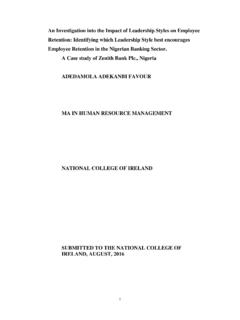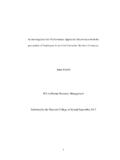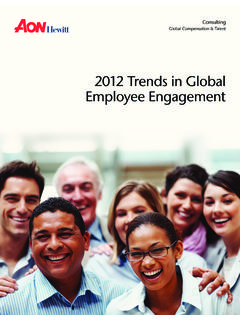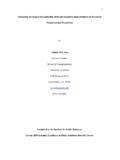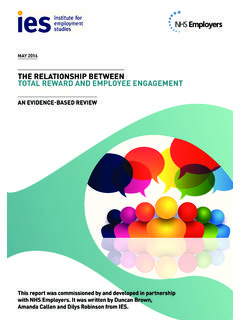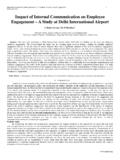Transcription of TITLE: A MEASUREMENT OF EMPLOYEE …
1 TITLE: A MEASUREMENT OF EMPLOYEE engagement USING THE GALLUP Q12 WORKPLACE AUDIT AUTHOR: FIONA VALE DEGREE BA (HONS) IN HRM YEAR 2011 This dissertation is submitted in partial fulfilment of the requirements for the Bachelor of Arts (Honours) in Human Resource Management, 2011. School of Business National College of Ireland 2011 Norma Smurfit Library National College of Ireland Research Students Declaration Form (Thesis/Author Declaration Form) Name: Fiona Vale Student Number: x03285308 Degree for which thesis is submitted: BA (Hons) in HRM Material submitted for award (a) I declare that the work has been composed by me. (b) I declare that all verbatim extracts contained in the thesis have been distinguished by quotation marks and the sources of information specifically acknowledged. (c) My thesis will be included in electronic format in the College Institutional Repository TRAP (thesis reports and projects) (d) I declare that no material contained in the thesis has been used in any other submission for an academic award.
2 Signature of research student: _____ Date: _____ i ABSTRACT The term EMPLOYEE engagement is relatively new with the concept introduced by Kahn in 1990 as personal engagement and personal disengagement . Despite increasing interest (Frauenheim, 2009; Kular et al, 2008; Robertson-Smith and Markwick, 2009; Saks, 2006; Shuck and Wollard, 2010) there is still no clear definition of the term and little academic research has been carried out (Saks, 2006). Numerous professional firms such as Gallup, Towers Perrin, BlessingWhite, ASTD and the Conference Board have carried out studies of EMPLOYEE engagement over the past number of years. Research by these firms has shown a correlation between EMPLOYEE engagement and profit (Harter et al, 2002; Harter et al, 2009; Towers Perrin, 2008). Towers Perrin s 2007-2008 global workforce study showed that operating income increased by 19% over one year in firms with high EMPLOYEE engagement (Towers Perrin, 2008).
3 The purpose of this research is to measure levels of EMPLOYEE engagement and to add to the existing knowledge pool of academic research on the topic of EMPLOYEE engagement . A quantitative questionnaire replication of the Gallup Q12 workplace audit was selected for the purpose of data collection for this review given its validity and reliability (Harter et al, 2009). Gallup s Q12 workplace audit states that only highly engaged employees will respond in strong agreement to each of twelve statements (Forbringer, 2002). The findings did not ii demonstrate a higher level of engagement to what was anticipated based on Towers Perrin s 2007-2008 Global Workforce Study where engagement levels provided were at 21%. The engagement levels found in this research report were at , just below that level. Towers Perrin categorises employees as enrolled where they are capable but not fully engaged (Towers Perrin, 2008).
4 This category represented of respondents to the online survey. The remainder, the disenchanted or disengaged made up of respondents. ACKNOWLEDGEMENTS Thanks to Patricia Power (PhD), Sarah Barry and Rebecca Towers without whose support this project may not have been completed. Thanks also to Susann Prenderville for her good humour over the past four years of Saturdays we finally made it! I owe a debt of gratitude to my colleagues who participated in this year s research as well as last year s; thank you! TABLE OF CONTENTS CHAPTER 1: INTRODUCTION .. 1 1 What exactly is EMPLOYEE engagement ? .. 1 Why be concerned with EMPLOYEE engagement ?.. 2 Previous research on EMPLOYEE engagement .. 2 Research strategies used to date .. 3 Intended outcome of this research .. 3 Limitations .. 3 4 Structure of the report .. 4 CHAPTER 2: LITERATURE REVIEW .. 5 5 Definition(s) of EMPLOYEE engagement .. 5 Researchers of EMPLOYEE engagement .
5 6 Opposing views from burnout 8 Conclusion .. 9 CHAPTER 3: METHODOLOGY .. 10 10 Paradigm Assessment and statement .. 10 Methodological strategy .. 10 Research purpose .. 11 Process .. 11 Site and population .. 12 Sampling .. 12 Research strategy .. 12 Logic .. 14 Outcome .. 14 Data collection methods .. 15 Trust .. 15 Bias (and solution) .. 15 Ethics .. 16 Data analysis .. 16 Analysis strategy .. 16 Reason for selection the Gallup Q12 workplace audit .. 17 Design of the Q12 17 CHAPTER 4: RESULTS .. 18 18 Sample population .. 18 Return rate .. 19 Completion rate .. 19 Initial findings .. 19 Introductory section of the survey questionnaire .. 20 Gallup Q12 statements .. 26 Overall satisfaction .. 26 Question nine: Change in satisfaction .. 27 The twelve Gallup Q12 statements .. 28 Cross-tabulated responses .. 35 Cross-tabulation across gender .. 36 Cross-tabulation of age groups .. 40 Cross-tabulation against length of service.
6 49 CHAPTER 5: DISCUSSION .. 57 57 Analysis of findings against Forbringer s 4 levels .. 57 Level 1: What do I get? .. 57 Level 2: What do I give? .. 58 Level 3: Do I belong here? .. 59 Level 4: How can we all grow? .. 61 Correlation of findings to engagement .. 62 Analysis of findings against research .. 62 Possible shortcomings to the research .. 64 Research 65 Possible directions for future research .. 65 CHAPTER 6: CONCLUSION .. 66 66 engagement levels of 66 Future focus for managers .. 66 Future focus for research .. 66 CHAPTER 7: REFERENCES / BIBLIOGRAPHY .. 68 CHAPTER 8: APPENDICES .. 71 Appendix 1: Communication to participants .. 71 Appendix 2: Survey 72 Appendix 3: Copy of responses .. 78 LIST OF ILLUSTRATIONS Figure 4:1 Question one: 20 Figure 4:2 Question two: Age group .. 21 Figure 4:3 Question three: Length of service .. 22 Figure 4:4 Question four: Role type .. 23 Figure 4:5 Question eight: Satisfaction with company.
7 27 Figure 4:6 S1: Expectation at work .. 28 Figure 4:7 S2: Necessary materials and equipment .. 29 Figure 4:8 S3: Opportunity to do your best .. 29 Figure 4:9 S4: Recognition or praise received .. 30 Figure 4:10 S5: Caring .. 30 Figure 4:11 S6: Encouragement .. 31 Figure 4:12 S7: My opinion is counted .. 31 Figure 4:13 S8: Company mission impact on role .. 32 Figure 4:14 S9: Colleagues commitment .. 32 Figure 4:15 S10: Best friend at 33 Figure 4:16 S11: Progress review .. 34 Figure 4:17 S12: Opportunities to learn and grow .. 34 Figure 4:18 Cross-tabulation of male respondents .. 36 Figure 4:19 Cross-tabulation of female respondents .. 38 Figure 4:20 Cross-tabulation of age group 20-29 .. 41 Figure 4:21 Cross-tabulation of age group 30-39 .. 43 Figure 4:22 Cross-tabulation of age group 40-49 .. 45 Figure 4:23 Cross-tabulation of age group 50+ .. 47 Figure 4:24 Cross-tabulation of 1-2 yrs service .. 49 Figure 4:25 Cross-tabulation of 3-4 yrs service.
8 51 Figure 4:26 Cross-tabulation of 5-10 yrs service .. 53 Figure 4:27 Cross-tabulation of 10+ yrs service .. 55 LIST OF TABLES Table 4:1 Question one: Gender .. 21 Table 4:2 Question two: Age group .. 22 Table 4:3 Question three: Length of service .. 23 Table 4:4 Question four: Role type .. 24 Table 4:5 Question five: Corporate title .. 24 Table 4:6 Question six: Job location .. 25 Table 4:7 Question seven: Other role type .. 25 Table 4:8 Question eight: Satisfaction with company .. 27 Table 4:9 Participant number within age groups .. 35 Table 4:10 Participant number against length of service .. 35 Table 4:11 Participant number within gender .. 35 Table 4:12 Cross-tabulation of male participants .. 37 Table 4:13 Cross-tabulation of female respondents .. 39 Table 4:14 Cross-tabulation of age group 20-29 .. 42 Table 4:15 Cross-tabulation of age group 30-39 .. 44 Table 4:16 Cross-tabulation of age group 40-49 .. 46 Table 4:17 Cross-tabulation of age group 50+.
9 48 Table 4:18 Cross-tabulation of 1-2 yrs service .. 50 Table 4:19 Cross-tabulation of 3-4 yrs service .. 52 Table 4:20 Cross-tabulation of 5-10 yrs service .. 54 Table 4:21 Cross-tabulation of 10+ yrs service .. 56 Table 5:1 Mean % average for 12 statements .. 62 1 CHAPTER 1: INTRODUCTION Introduction This chapter introduces the concept of EMPLOYEE engagement (section ) and outlines why it is a topic of concern (section ). Previous research will be discussed briefly in section and elaborated on and critically analysed in chapter two. The strategies employed by previous researchers are discussed in section and the intended outcome of the present research is summarised in section Sections and set out the limitations and delimitations of the present research respectively. Finally, the structure of the remainder of the report is set out in section What exactly is EMPLOYEE engagement ? The term EMPLOYEE engagement is relatively new with the concept introduced by Kahn in 1990 as personal engagement and personal disengagement.
10 Despite increasing interest in EMPLOYEE engagement (Frauenheim, 2009; Kular et al, 2008; Robertson-Smith and Markwick, 2009; Saks, 2006; Shuck and Wollard, 2010) there is still no clear definition of the term and little academic research has been carried out (Saks, 2006). A Google search on the definition yields over 650,000 results. Robertson-Smith and Markwick (2009) set out a number of definitions of EMPLOYEE engagement given by organisations including Vodafone, Johnson and Johnson, BT, Dell and Nokia Siemens Networks with the common theme that EMPLOYEE engagement goes beyond satisfaction and motivation; engaged employees give of their best and have a contagious enthusiasm; are advocates of their company, and invest extra effort to go above and beyond their given role. Academic literature has also failed to provide consensus on a concise definition of EMPLOYEE engagement . 2 Why be concerned with EMPLOYEE engagement ?
